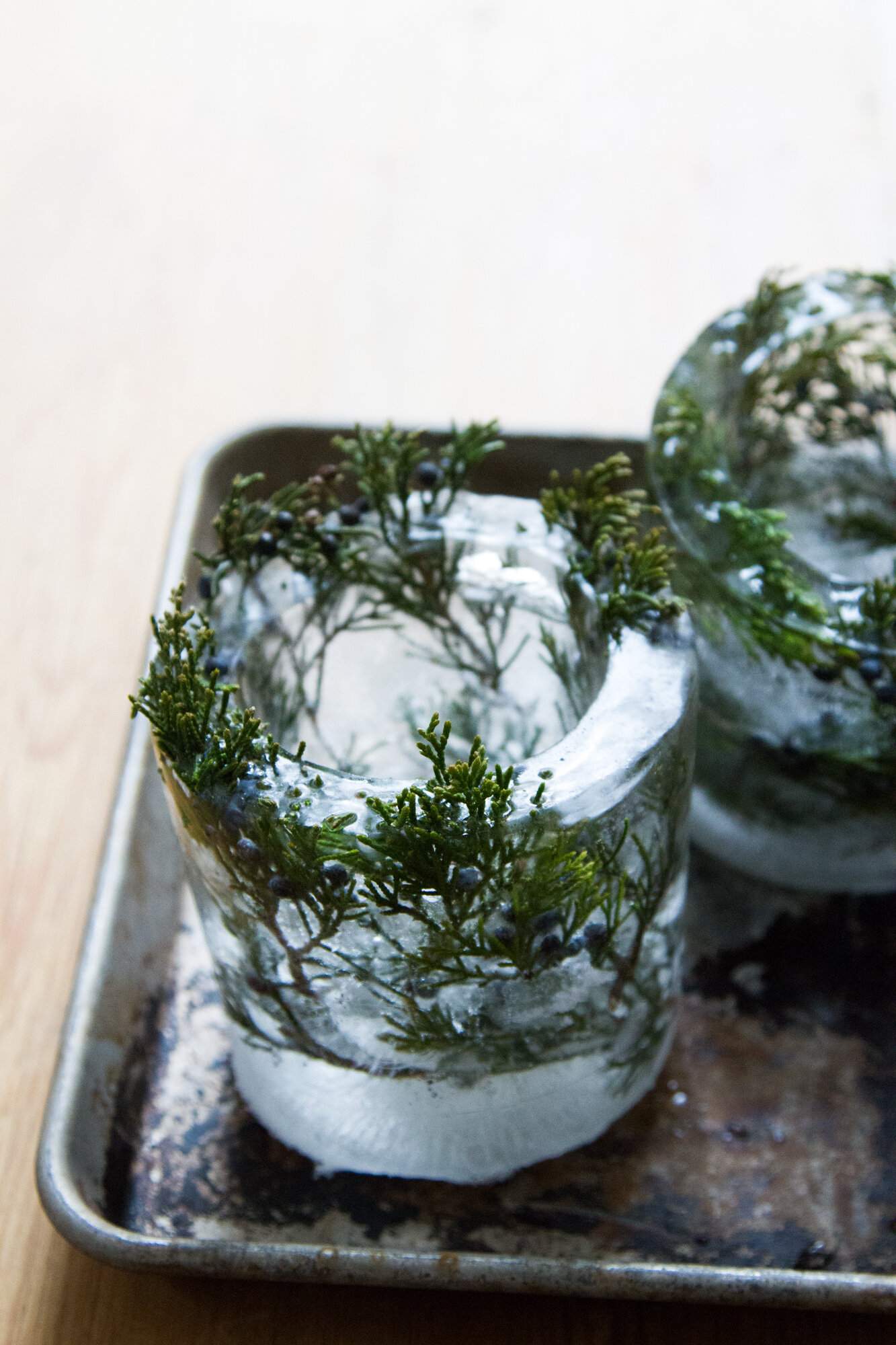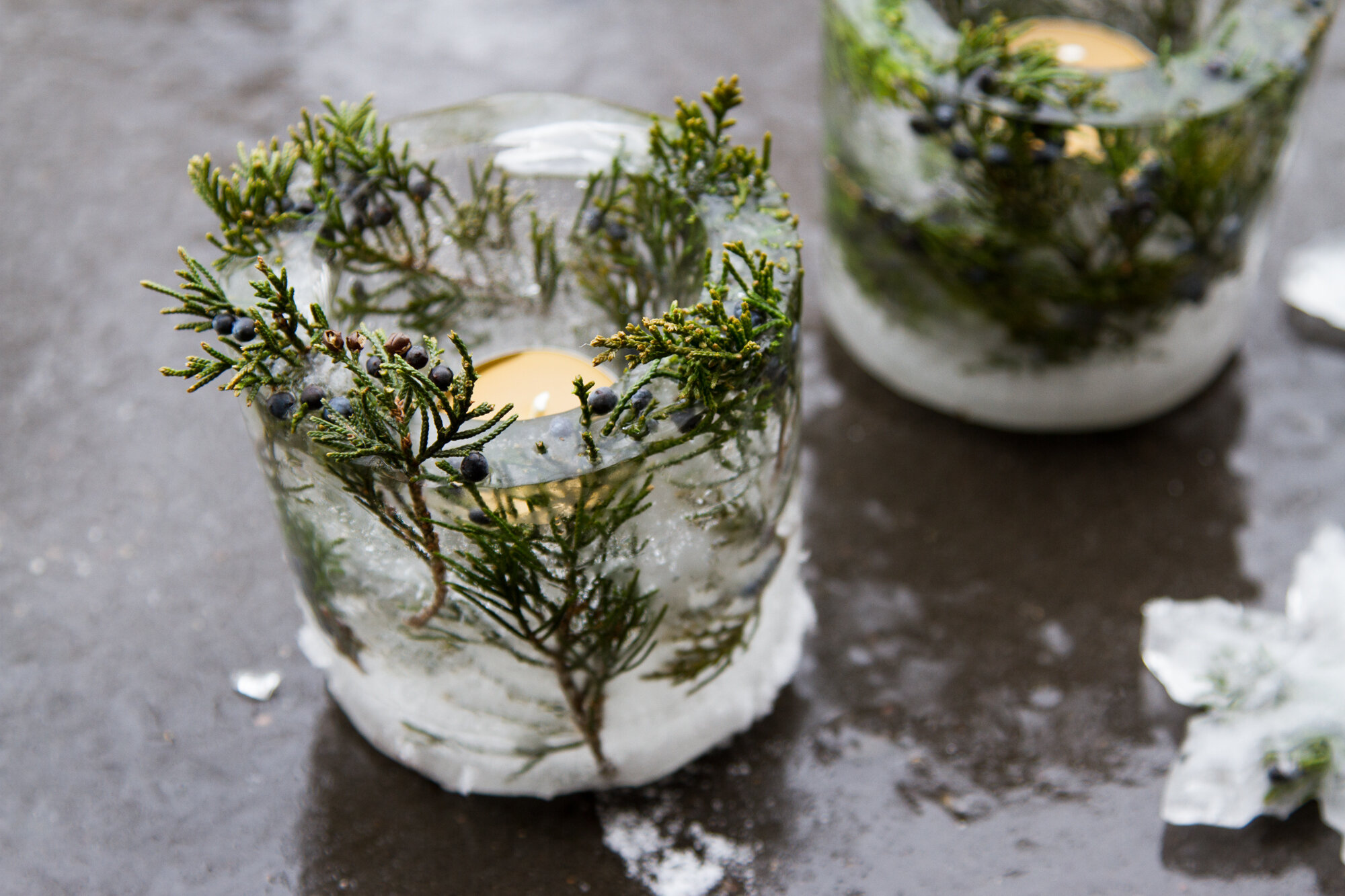
Growing up, I’d light luminaria with my Uncle Ralph on Christmas Eve. He’d have filled the bottoms of white paper bags with beach sand and lined them up along the edge of his street. We’d trip from bag to bag, lighting votives with long barbecue lighters. Neighbors would come out of their houses to light the bags in front of their homes until the whole street was lined with flickering light. When we took the sleepy drive back to our own town, we’d wind through a beachside neighborhood alight with neighborly good cheer.
These ice lanterns are a little more cold-weather dependent than the paper version, but they’re the perfect thing to try if you’re in a spot where temperatures are low and nights are long.
I first wrote about making these ice lanterns when I worked for Gardenista. In the years since then, all of my Weck jars have succumbed to expanding ice, so this year when I noticed a small yogurt container left behind in our recycling bin by our beloved babysitter, I scooped it up to use as a more foolproof alternative. A few weeks later I found another, and I saved both alongside the larger yogurt containers we buy for ourselves. When the temperatures finally hit freezing last week, I pulled my collection from its spot under the sink, and voila, lanterns. 
I use a bit of tape to hang the smaller container inside the larger one, trying my best to center it. (A process made easier with a second set of hands.)
 I stuffed the sides with bits of juniper and then filled it up with water, but you can add anything you’d like. Bright red winterberries would be a festive alternative to the juniper, if you prefer red at Christmastime.
I stuffed the sides with bits of juniper and then filled it up with water, but you can add anything you’d like. Bright red winterberries would be a festive alternative to the juniper, if you prefer red at Christmastime.
Just like the ice ornaments that we made, we relied on our freezer to set the lanterns, but in a cold spot you could leave these outside to freeze instead. 
Once frozen solid (I left mine in the freezer overnight) run a little warm water around the yogurt container to loosen the lantern from the mold. 
While I waited for my ice lanterns to freeze, I experimented with freezing shapes in cookie cutters. (I found the process to be satisfying but a little more cumbersome, since water seeps out and you need to flood your tray and then break up and melt the ice that forms around the outside of the cookie cutter. Still, worthy of the experiment!
I love the bits of juniper that stand up above the top of the mold. 
I used beeswax tealights that I poured for my lanterns, but if you’d prefer to leave yours unattended, you could also use faux battery-operated tea lights.
Happy winter solstice, friends! Here’s to more light!




16 Comments
These are absolutely gorgeous! I’d love to try them out, I’m just never really good with my hands.. *hides away* How long did they last before starting to melt?
Ours lasted two days before melting, but all depends on the temperatures of course!
Oh my, total flash back, I made these as a kid! I was always checking out craft books from the library and trying every craft my mom would let me do. I might have to revisit this one.
These are very beautiful and I too like the way you let the branches be above the water line. Did you use regular tape water? i read somewhere that the ice is cloudy if you don’t. yours look nice and clear. Have a wonderful holiday.
Used water from our kettle, so it had been boiled! Might be why they’re fairly clear!
* tap water
These are SO beautiful! Must try! and happy solstice. 🙂
So pretty!
Maybe use silicone molds instead of cookie cutters? I have a silicone bundt pan that would look like a wreath…
I didn’t want to invest in anything new myself, but I bet that would work well!
Any tips for finding juniper or winterberries?
Not sure where you are in the world, but junipers are native to much of the US and winterberries are native to the Northeast so you can keep an eye out for them in the wild. Otherwise, both are also commonly found in florist shops this time of year.
If you live in New England, winter berries can often be found on the side of the road or at the edge of boggy/wet areas. Just be careful not to harvest more than 10% of what is there — the birds and critters rely on the berries to eat during these cold months.
So beautiful and creative. I look forward to each one of your posts– always simple and inspiring!
This is a huge tradition in Finland! Many families make these every year, and many of them use buckets too 🙂 It’s such a fun and cheap way to make something so beautiful.
Heidi ✨
These are so incredibly beautiful! Unfortunately where I live in Australia even in the middle of winter these would melt very quickly. We just don’t get a true winter down here.
Comments are moderated.